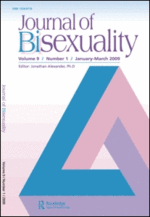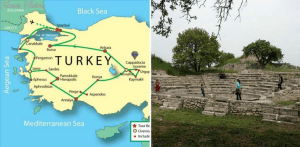
Bi Book Review by Hudi Shorr
will appear in Bisexuality and Spirituality, a special-topics issues of
The Journal of Bisexuality, edited by Loraine Hutchins
pre-published with permission
will appear in Bisexuality and Spirituality, a special-topics issues of
The Journal of Bisexuality, edited by Loraine Hutchins
pre-published with permission
Gaia and The New Politics of Love: Notes for a Poly Planet
Serena Anderlini D’Onofrio,
North Atlantic Books, Berkeley, CA, 2009
Reviewed by Yuhudis (Hudi) Schorr
Our world is in crisis amidst wars.
Military wars are robbing mothers’ of their children, and people of their land. Political wars are pitting the people of our nation against one another, forcing them to take positions that may make the boundaries between those who have and those who cannot afford to have, more clear and defined than ever before.
Religious wars are abundant around the globe, attempting to justify the denial of basic rights of freedom as the word of God. The Earth has been catapulted into a state of chaos; the wars that we are waging upon her have taken their toll. Never before have we witnessed such levels of increased poverty and environmental degradation. In our time, the human species has acquired the capability to destroy both human life and the biosphere that hosts it.
Gaia and the New Politics of Love: Notes for a Poly Planet is a masterpiece by Serena Anderlini-D’Onofrio that offers us a chance to transform crises into opportunity. Using science and nature as her backdrop, Anderlini-D’Onofrio constructs a new politics of Gaian symbiosis that affirms love as the force with which we must affect change in our universe, if we, as a species, are to survive our current state of environmental and political chaos.
In three sequential and interconnected parts Anderlini-D’Onofrio outlines a practical strategy to combat the toxic forces we have inflicted upon our planet. Using feminist ecological epistemology she offers an entirely new way of thinking about love, based upon teachings learned from bisexual and polyamorous communities that can offer a fresh perspective with which we can begin to repair the damage done to the biota that currently sustains us. If we are to survive the trauma to the Earth that we have caused, we must rethink our current conceptions of what that Earth is and the forces that we use to negotiate our way through it. We must expand beyond our currently limited definitions of love and family in order to include entire communities and the ecosphere that we inhabit. If we continue on our path of obsessive consumption of resources without regard to the harm we are causing, the biota will transform and survive, while our species will become one of the many extinct species that have at one point inhabited her live body.
Anderlini-D’Onofrio ominously warms us: if we continue to mistake Gaia for an assemblage of useable resources, we will kill ourselves, not her. It is now more than ever that we need her messages of warning, and instructions of repair.
I. Gaia in Feminist Science
Anderlini-D’Onofrio begins by placing her Gaian philosophy within a framework of feminist ecology. Ecofeminism postulates that Gaia, the Earth, has a life of its own. It has a consciousness like an animated, self-regulating organism. In ecofeminism, subject and object are largely the same, and control is replaced by more symbiotic dialogue and collaboration. This feminist epistemology effectively defeats the logic of either/or, and embraces a more inclusive logic of both/and. In this way, feminist ecologies debunk the myth of distinction between that which is “human” and that which is “nature”. A Gaian philosophy implies giving up our sense of entitlement as a species deluded to thinking that the biota is a resource to be exploited by us.
“If we humans can come back to viewing ourselves as a resource among other resources with no special entitlement to occupying the position of subject in opposition to a “natural world” that becomes objectified as existing for the sole purpose of meeting our needs, then we can find again forms of coexistence with each other and the planet that hosts our lives.” (Intro, xxii)
Symbiotic reason indicates that while there are no mere resources, every cell in Gaia’s body can function as a resource for another cell. Symbiosis is the practice of sharing bodies in which both symbionts, the host and the guest, benefit. We only have to look to nature to see examples all around us: the cow who hosts the bacteria in order to make her food, the womb that hosts the fetus to nurture its survival. All parts of the equation are beneficiaries of the give and take relationship, without losing their individual identities in the process. We: humans, animals, minerals, the very Earth herself are all part of the greater whole of Gaia, the process of life. The pain we inflict on nature is in fact pain we experience as a species, the growth we experience as individuals affects the world at large. A symbiotic logic requires us to view this bigger picture, and begins to develop lines of communication between the now disparate pieces that make up Gaia in order to find a more symbiotic harmony amongst them.
Symbiotic reason is more apt than individual reason to understand life as an interrelated web in which each individual is a small node that exists thanks to others’ presence. The author points to the behavior of growth among trees and roots. Our ecosystem contains two kinds of intricate growth processes amongst vegetation. There are the arborescent plants: treelike growths organized as individual trees that sprout from a seed and grow vertically by sinking their roots deeply in the soil, and the rhizomes, such as gingerroots and potatoes which operate as subterranean root networks that grow sideways, store resources within the soil, and intermittently sprout interrelated plants across the terrain where the rhizome is present. A tree species may have strong individuals who grow to be taller and more powerful than any plant sprouting from a rhizome, but the rhizome in itself is more resilient to adversity and ecological changes due to their numerous points of entry. For Anderlini-D’Onofrio, the rhizome can represent the Gaian principle of evolution by symbiogenesis, the symbiotic process by which a species acquires the genes of its symbionts into its own DNA. This process is more horizontal. Anderlini-D’Onofrio argues that all life is symbiotic because biology shows that without exchanges between interrelated beings, there would be no life at all. It is within this reasoning that she has developed her new politics of love.
II. Politics of Love
Anderlini-D’Onofrio’s politics of love is new way of looking at love that draws from ancient teachings of a sacred feminine to postmodern understandings of health. Our current notions of health are monopolized by allopathic discourse that views health as the absence of disease and medicine a war against its attacks. It ignores the fact that perhaps disease is not a foreign attack on the body, rather a part of the body itself, crying out for repair. Holistic discourse on the other hand realizes a symbiotic alignment of an ecosystem’s dynamic parts. Disease is viewed as a message from the body that demands a change in its ecology. Gaian awareness compels us to shift our current paradigms of health from an overwhelming allopathic discourse to more holistic notions of health, all the while invoking symbiotic reasoning to encourage dialogue between the allopathic and holistic health collectives.
The AIDS crisis played a massive role in positioning love on the side of disease. Through criminalizing loving communities, a rhetoric of fear was born, which produced a social energy that linked erotic expression with fear. A new politics of love seeks to reverse this trend by transforming its negative social energy into a positive one that reconnects erotic expression with safety and well-being. Hypothesizing Gaia helps the world shed needless fears from current dogmas of love as a crime or a disease.
In a holistic perspective, players are encouraged to enhance the health practices that strengthen their immunity and hence their health. This follows the Gaian principle that the health of Gaia’s body is proportionate to the health of each of her cells. Conventional allopathic medicine tends to attack the symptoms that express the body’s problem, and may neglect to seriously investigate its causes (63). As Anderlini-D’Onofrio posits: if an individual is a cell in a super organism, his/her disease cannot be a foreign agent, for all agents are part of the larger entity of which that individual is an element. Disease in the elements of a super organism is a force that manifests a crisis in its life. Disease is thus read as a message that can help the living ecosystem deal with the crisis and reconfigure itself (71).
The AIDS epidemic can be read as a crisis within Gaia, and as such, a signal for systemic change. Excessive emphasis on allopathic hypotheses in sexual health has kept the world stuck in a mode of fear. Anderlini-D’Onofrio’s Gaia hypothesis postulates that the planet Earth is a web of interconnected organisms with a life of its own, a postmodern perspective that reverberates with indigenous, ecofeminist, pre-modern, and symbiotic cultural elements (102). In Gaian post modernity, “sex” is an erotic expression, the joy of taking and giving, and the orgiastic revitalizing pleasures of bacteria. It is the art of loving that lives in the wider space of the arts of healing, and as an art, is shy of any normativity (110). Western masculinity emphasizes control over intimacy. It acts like a cultural imperative that dominates modern philosophical discourse reflected in Western modernity’s obsession with the mastery of nature. The idea that humans can master nature is but a myth of modernity. The reality is that humans cannot master nature, and there is no reason why they should (113).
Reconfigured as ecological erotic orientations, the love styles that correspond to former perversions are found to have a positive effect on Gaia’s health for various reasons: They multiply the possibilities of love; they help expand the boundaries of the loving arts; and they contribute to establishing regimes of love that help in the sharing of resources and the creation of sustainable emotional communities (123-4). Love is free, and it can be multiplied at will. Anderlini-D’Onofrio defines it as “a renewable resource that saves one from the trappings of useless consumerism” (125). The healing arts emphasize practices of the body that redeem people from modernity’s secular materialism. They are effective in empowering people and communities to heal themselves by creating a more symbiotic understanding of us as individuals, without losing the connectivity to each other and our Mother Gaia. As Anderlini-D’Onofrio so eloquently writes, “this may not instantly resolve all global problems, but the perspective it puts things in vastly improves the prospects for healthy global ecologies” (127).
III. The Arts of Loving
In this part of her book, Serena Anderlini-D’Onofrio articulates why she feels that bisexual and polyamorous communities provide the framework to actualize a Gaian awareness of living. Bi/Poly communities generate areas of stability of erotic awareness and emotional sustainability that free the imagination from needless fears and create the emotional and ecological abundance that Gaia needs (152). Because of their heavy reliance on touch, connectedness, non-violence, and a subtle knowledge and practice of intimacy, the styles of love invented by poly and bi people promote the activation of the hormonal cycle of Oxytocin (137). Oxytocin is the hormone responsible for states of emotional calm and connectedness that often fills the aural and inner spaces of bi and poly societies. Oxytocin becomes a social lubricant within these communities where playfulness is key. It is the gentle playfulness produced by these arts of loving that enable emotional negotiations and agreements that would otherwise be impossible in an environment without it.
The styles of love practiced in bi and poly communities help build the trust necessary to overcome fears and are often intentionally designed to break down people’s defensive identities, body armors and egos, so that all players can enjoy the free circulations of amorous energies. It is this symbiotic reason that transforms scarcity into abundance.
Consumer society can be visualized as an extensive orgy inasmuch as it is organized as a continuum orgiastic display of material temptations that induce desire for things we often don’t need or want (163). Anderlini-D’Onofrio writes that the combined practices of bi and poly love have the power to allow individual players to become part of the “flow of the orgy”, to consciously navigate its flow and become consensually immersed into the movement of the symbiotic energy generated by our aural, astral, and physical bodies at play (163). This results in sustainability, balance, and renewability of resources for all involved, and it maximizes a player’s ability to give and receive love. She writes:
“As players learn to navigate this emotional/erotic space, the dialogue between the emotional and erotic realms enables them to maximize the love energy they can share. This sharing of emotional resources generates symbiotic energy fields between players, and enables the creation of emotional sustainability that result in symbiotic plateaus of enhanced awareness. These plateaus involve crises that manifest at certain points in the network, and whose collective management can productively turn them into opportunities for deeper levels of symbiosis. This growth and change can move the entire network on a higher level of awareness that enables more focused and productive experiments in the management of shared emotional resources and the symbioses therefore. The network thus functions like a sustainable ecosystem for all of these interpersonal energies. It generates the sustainability, balance, and renewability of resources for all involved” (165).
Applied on a global scale, this turns scarcity into abundance, fear into hope, and hatred into love. This transformation happens when we players lose our intense sense of entitlement to the resources that surround us in our ecosphere. The tools of this transformation can be found in the schools of bisexual and polyamorous philosophy where intentional communities are formed by people who consciously choose to live by a shared utopian vision, motivated by Gaian principles. They share an expansive sense of love and sexual expression that involves consensual sharing of emotional and erotic resources and can be learned at their schools (154).
Anderlini-D’Onofrio proposes a journey to these schools to learn the tools of the loving arts, regardless of one’s orientation or identity. These philosophies of both/and/all include and cherish all points in every continuum. They celebrate our diversities and encourage us to recognize each other and harmonize ourselves with Earth’s symbiotic ecosystem. If we can take from them the ability to think of love as an art whose forms of expressions is infinite, then perhaps we can incorporate those healing and loving arts to stave off ecological catastrophes caused by our irresponsible behavior as a species.
Imagine A Better World
We must begin to imagine a world that is better than the current one we inhabit, where wars are beings waged, and fear is abundant. Serena Anderlini-D’Onofrio has directed us upon a path that might open our imagination to new and thrilling ideas that, if we allow ourselves to be open enough to consider them, can restore our planet to a place of homeostatic symbiosis; a world where we both give and take from what and whom is around us instead of stripping all of their available resources and leaving desolation in our wake. Gaia and the New Politics of Love offers us a glimpse as to what a world without animosity, soaked in selfish consumption might look like: a place where differences and individuals thrive together while dedicating themselves to the health of Gaia, that which came before us and will sustain herself after we pass.
Perhaps with this new model emphasizing non-violent, loving sustainability we might do our part in ending the wars and restoring Gaia to her harmonic balance, thus ushering in the new era of planetary peace and health, based on mutual respect and love, that our world surely needs today.
http://polyplanet.blogspot.com


